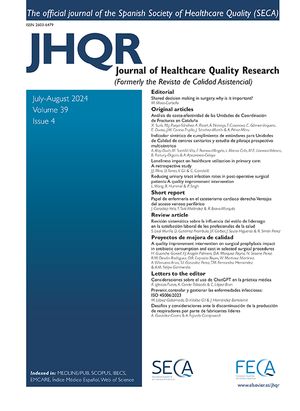Demostrar que una adecuada protocolización de la asistencia quirúrgica y posquirúrgica permite disminuir la estancia hospitalaria en la cirugía ginecológica laparotómica benigna sin aumentar la morbilidad y manteniendo los estándares de calidad.
Pacientes y métodoComparamos la estancia media hospitalaria de dos grupos homogéneos de pacientes: uno control de 54 pacientes y otro de estudio de 53, con procesos benignos ginecológicos a las que se practicó cirugía laparotómica. Al grupo de estudio se le sometió a un protocolo definido para facilitar el alta lo más tempranamente posible.
ResultadosAmbos grupos fueron comparables respecto al tipo de ingreso, de cirugía practicada, comorbilidad, complicaciones y situación al alta. La estancia preoperatoria no evidenció diferencia significativa (p = 0,20). La estancia hospitalaria fue de 7,8 días para el grupo control y de 6,1 para el de estudio, existió una diferencia significativa entre ambos (p = 0,004). En ninguno de los grupos se presentó reingreso antes de 30 días ni relacionados. No se registraron reclamaciones ni sugerencias relacionadas con la duración de la estancia en atención al paciente.
ConclusionesResulta posible una reducción de la estancia hospitalaria posquirúrgica para procedimientos ginecológicos, y ésta actua de forma adecuada sobre los protocolos de cuidados postoperatorios.
To demonstrate that appropriate protocols for surgical and postsurgical care reduce hospital stay after laparotomic procedures for benign gynecological disease and enable standards of health care quality to be maintained without increasing mortality.
Patients and methodWe compared the mean length of hospital stay in two homogeneous groups of patients: a control group of 54 patients and a study group of 53 patients with benign gynecological processes who underwent laparotomic surgery. A protocol designed to achieve hospital discharge as quickly as possible was applied in the study group.
ResultsIn both groups, type of admission, the surgery performed, comorbidity, complications and length of stay were similar. No significant differences were found in preoperative stay (p = 0.20). Hospital stay was 7.8 days in the control group and 6.1 days in the study group. This difference was statistically significant (p = 0.004). There were no readmissions in the first 30 days in either group. No complaints or suggestions related to length of hospital stay were lodged in the Patient Affairs Unit.
ConclusionsLength of hospital stay for gynecological procedures can be reduced by following protocols for postsurgical care.






